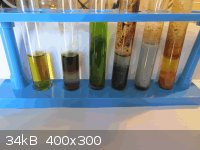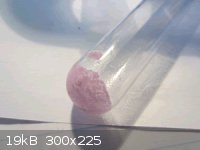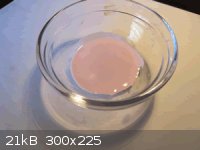| Pages:
1
..
11
12
13
14
15
..
24 |
blogfast25
International Hazard
    
Posts: 10562
Registered: 3-2-2008
Location: Neverland
Member Is Offline
Mood: No Mood
|
|
Nice euphemism  'Mineral sulphate of potash' would have been more accurate. 'Mineral sulphate of potash' would have been more accurate.
|
|
|
Brain&Force
Hazard to Lanthanides
    
Posts: 1302
Registered: 13-11-2013
Location: UW-Madison
Member Is Offline
Mood: Incommensurately modulated
|
|
I made some magnet nitrate today, dissolving a few small magnets in 6M nitric acid. They were unusually slow to dissolve and no visible amount of
NO2 was produced. They were not demagnetized and only partially stripped of their coating, so there is Ni(NO3)2 in
solution as well. I added some potassium sulfate and heated the solution to encourage precipitation, but nothing came out. As with the terbium I've
decided to wait for next week in case supersaturation occurred.
There were also white flakes floating in solution that eventually dissolved...I wonder what that was.
At the end of the day, simulating atoms doesn't beat working with the real things...
|
|
|
MrHomeScientist
International Hazard
    
Posts: 1806
Registered: 24-10-2010
Location: Flerovium
Member Is Offline
Mood: No Mood
|
|
White flakes could possibly be boric acid from the boron in the magnets. Somewhere in the thread I reported finding some white flakes after filtering,
which tested (not conclusively) positive for boron. Yours might not have precipitated because there was not enough sulfate in solution, possibly. In
my case at least I used sulfuric acid so there was plenty available for the double salt. Did you add enough sulfate calculated to saturate the
soluton?
|
|
|
Brain&Force
Hazard to Lanthanides
    
Posts: 1302
Registered: 13-11-2013
Location: UW-Madison
Member Is Offline
Mood: Incommensurately modulated
|
|
I think I didn't use enough magnets (this was just a test with two tiny magnet fragments, about .5 gram). I'll try boiling the solution down further,
or dissolving more magnets.
[Edited on 1-2-2014 by Brain&Force]
At the end of the day, simulating atoms doesn't beat working with the real things...
|
|
|
blogfast25
International Hazard
    
Posts: 10562
Registered: 3-2-2008
Location: Neverland
Member Is Offline
Mood: No Mood
|
|
Why waste precious nitric when you've got 6 M HCl (as I recall)? To dissolve also the Ni cover?
I always demag first (put them on a hot plate on full), then crack them with a hammer. Then 12 M HCl. When it's more or less done, I filter off the
residue and subject it once more to a small amount of 12 M HCl because there's usually a bit of magnet metal lurking in the corners of the coating.
Then calculate the amount of K2SO4 to saturate the volume, add it, simmer for a bit and allow to cool to RT and the Nd precipitates out as the double
sulphate. Filter and wash with pH < 3 wash water.
Because the double sulphate is not the end product there's no point in washing it further (after all Fe has been removed). I treat it with strong
ammonia immediately, simmer for a bit, hot filter and wash the Nd(OH)3 copiously with water.
|
|
|
Brain&Force
Hazard to Lanthanides
    
Posts: 1302
Registered: 13-11-2013
Location: UW-Madison
Member Is Offline
Mood: Incommensurately modulated
|
|
I just ran out of HCl, but I still have plenty of nitric. The magnets only dissolve with difficulty, though, and NO2 is not generated. One
of the problems might be that the magnets have been broken for a long time and have corroded.
[Edited on 1-2-2014 by Brain&Force]
At the end of the day, simulating atoms doesn't beat working with the real things...
|
|
|
blogfast25
International Hazard
    
Posts: 10562
Registered: 3-2-2008
Location: Neverland
Member Is Offline
Mood: No Mood
|
|
If you do get to Nd(OH)3, make sure you check out its fluorescence too. It really looks eerily different under an incandescent bulb as under a saver
bulb.
|
|
|
Brain&Force
Hazard to Lanthanides
    
Posts: 1302
Registered: 13-11-2013
Location: UW-Madison
Member Is Offline
Mood: Incommensurately modulated
|
|
Nd only fluoresces in the IR range. The effect is caused by absorption bands not lining up with the emission bands of light sources.
At the end of the day, simulating atoms doesn't beat working with the real things...
|
|
|
blogfast25
International Hazard
    
Posts: 10562
Registered: 3-2-2008
Location: Neverland
Member Is Offline
Mood: No Mood
|
|
Huh? See these pictures of NdCl3.6H2O under sunlight and 'black light':
http://en.wikipedia.org/wiki/Neodymium(III)_chloride
I've seen this myself even though my NdCl3 was far from pure and I only used a UV counterfeit detector. ndF3 does it too: blueish (sunlight) to
greenish (UV rich light).
|
|
|
Brain&Force
Hazard to Lanthanides
    
Posts: 1302
Registered: 13-11-2013
Location: UW-Madison
Member Is Offline
Mood: Incommensurately modulated
|
|
It's not black light, it's a fluorescent energy saving bulb. The color change is caused by narrow absorption bands caused by forbidden f-f
transitions.
See http://woelen.homescience.net/science/chem/exps/neodymium/in...
If it really is fluorescent, I would love to see photos.
The wiki explanation of the effect is dead wrong, a charge transfer only occurs in melts of NdCl3.
At the end of the day, simulating atoms doesn't beat working with the real things...
|
|
|
blogfast25
International Hazard
    
Posts: 10562
Registered: 3-2-2008
Location: Neverland
Member Is Offline
Mood: No Mood
|
|
You are right, B%F. The colour change of Nd(OH)3 and NdF3 in incandescent v. saver bulb light is so striking I always believed it was due to UV
fluorescence.
|
|
|
Brain&Force
Hazard to Lanthanides
    
Posts: 1302
Registered: 13-11-2013
Location: UW-Madison
Member Is Offline
Mood: Incommensurately modulated
|
|
Here's a video showing the same effect in holmium triflate: https://www.youtube.com/watch?v=GEK90hf49Jk
Is Nd fluoride supposed to be green or was there Pr contamination in your sample?
At the end of the day, simulating atoms doesn't beat working with the real things...
|
|
|
blogfast25
International Hazard
    
Posts: 10562
Registered: 3-2-2008
Location: Neverland
Member Is Offline
Mood: No Mood
|
|
It's supposed to be blueish purple, which it was. It was magnet Nd, so Pr cannot be excluded but I doubt if there was any there.
Under saver bulb it looks greenish.
MrHS has some photos of his NdF3 higher up in this very thread, IIRW...
|
|
|
MrHomeScientist
International Hazard
    
Posts: 1806
Registered: 24-10-2010
Location: Flerovium
Member Is Offline
Mood: No Mood
|
|
Yes my first batch of NdF3 was green under small fluorescent tube lights and pink in daylight. My second batch, where I was more careful
about purity, was a clean white instead of green. The photos are in this thread somewhere.
|
|
|
Brain&Force
Hazard to Lanthanides
    
Posts: 1302
Registered: 13-11-2013
Location: UW-Madison
Member Is Offline
Mood: Incommensurately modulated
|
|
I evaporated the magnet nitrate to dryness, but I fear I have caused everything to hydrolyze.
I added some more nitric acid to the hydrolyzed product. At the same time another, larger magnet fragment was added to the mix. This time, the magnet
dissolved in a huge puff of NO2 and no trace of it remained after 2 minutes. I still need to add more nitric acid to the mix to redissolve
the rest of the hydrolyzed product.
At the end of the day, simulating atoms doesn't beat working with the real things...
|
|
|
blogfast25
International Hazard
    
Posts: 10562
Registered: 3-2-2008
Location: Neverland
Member Is Offline
Mood: No Mood
|
|
Not sure why you wanted to do that?
|
|
|
Brain&Force
Hazard to Lanthanides
    
Posts: 1302
Registered: 13-11-2013
Location: UW-Madison
Member Is Offline
Mood: Incommensurately modulated
|
|
Actually, I don't know either.  I was attempting to reduce the volume of the
solution, and for some reason I just let it evaporate. I was attempting to reduce the volume of the
solution, and for some reason I just let it evaporate.
At the end of the day, simulating atoms doesn't beat working with the real things...
|
|
|
blogfast25
International Hazard
    
Posts: 10562
Registered: 3-2-2008
Location: Neverland
Member Is Offline
Mood: No Mood
|
|
It should be fully recoverable with strong acid. All Fe will now probably be as Fe(III) so even closer control of pH will be needed to remove all of
it, assuming you're going the double sulphates route.
|
|
|
Brain&Force
Hazard to Lanthanides
    
Posts: 1302
Registered: 13-11-2013
Location: UW-Madison
Member Is Offline
Mood: Incommensurately modulated
|
|
I added an excess of nitric acid but it's still not dissolving! Any tips for making this dissolve faster?
Also, will sodium or ammonium sulfate work to precipitate the Nd? Or is potassium sulfate the best option? I don't have much potassium sulfate.
At the end of the day, simulating atoms doesn't beat working with the real things...
|
|
|
blogfast25
International Hazard
    
Posts: 10562
Registered: 3-2-2008
Location: Neverland
Member Is Offline
Mood: No Mood
|
|
Quote: Originally posted by Brain&Force  | I added an excess of nitric acid but it's still not dissolving! Any tips for making this dissolve faster?
Also, will sodium or ammonium sulfate work to precipitate the Nd? Or is potassium sulfate the best option? I don't have much potassium sulfate.
|
What acid strength are you using? Prolonged heat may be needed to get everything back into solution.
The Na/REE double sulphates are also quasi-insoluble. I believe also the ammonium ones are, IIRW. To be on the safe side, use Na2SO4, this has been
reported to have been used for this type of separation, in several references.
|
|
|
MrHomeScientist
International Hazard
    
Posts: 1806
Registered: 24-10-2010
Location: Flerovium
Member Is Offline
Mood: No Mood
|
|
I used sodium sulfate in my separation attempt on the previous page, and it appears to work nicely. I seem to recall somewhere else in this thread it
was mentioned that the potassium double salt has the lowest solubility of all.
I actually just got some sodium thiocyanate in the mail yesterday, so I'm finally able to test for iron contamination. I've been out with a stomach
virus all week, though, so experimentation has been put on hold for a while.
|
|
|
Brain&Force
Hazard to Lanthanides
    
Posts: 1302
Registered: 13-11-2013
Location: UW-Madison
Member Is Offline
Mood: Incommensurately modulated
|
|
My experience with terbium shows that simple rinsing is all that is needed to remove Fe. Fe appears to quench the fluorescence of terbium potassium
sulfate, but simple rinsing is all that is needed to remove the iron and restore fluorescence.
I remember hearing about ammonium sulfate being used to remove rare earths; I'll try to dig up the reference.
At the end of the day, simulating atoms doesn't beat working with the real things...
|
|
|
blogfast25
International Hazard
    
Posts: 10562
Registered: 3-2-2008
Location: Neverland
Member Is Offline
Mood: No Mood
|
|
Quote: Originally posted by Brain&Force  | My experience with terbium shows that simple rinsing is all that is needed to remove Fe.
I remember hearing about ammonium sulfate being used to remove rare earths; I'll try to dig up the reference. |
If the metals are present as sulphates/double sulphates and the rinse is of low pH then yes, the ferric sulphate is simply washed out.
|
|
|
MrHomeScientist
International Hazard
    
Posts: 1806
Registered: 24-10-2010
Location: Flerovium
Member Is Offline
Mood: No Mood
|
|
Not very applicable to home chemistry, but I came across an interesting article today relating to neodymium magnet recycling: http://phys.org/news/2012-12-magnetic-idea-rare-earth-recycl...
Try it if you have the capability to boil magnesium! 
Unfortunately no progress on my own endeavor. I plan to finish cleaning up my lab this weekend, then get back to regularly-scheduled chemistry.
Apologies if anyone got overly excited by the thread bump! 
|
|
|
aga
Forum Drunkard
    
Posts: 7030
Registered: 25-3-2014
Member Is Offline
|
|
Knowing next to nothing, i thought i'd give Neodymium extraction a go, seeing as i have a few hard drives lying about.
About 125g of head actuator magnets were dissolved in 500ml of OTC 20% HCl solution. This took ages - about 1 week.
Filtering removed black/grey sludge and bits of the magnet jackets (presumably Nickel).
Nothing fell out of the resulting liquid after being left to stand for a few days, and it looks the same colour as weak ferric chloride to me.
Several reagents were added to 5ml samples of the resulting liquid, based on what was handy (see photos).
Left to right :
Liquid with nothing added
+Elemental copper
+Copper sulphate solution
+Sodium Hydroxide (s)
+Magnesium (s)
+Sodium MetaBisulphite.
Interesting and fun to do, but i read that the Nd3+ ion is a violet colour, so i thought it all wrong and started cleaning the test tubes.
The Copper Sulphate tube showed Violet 'crystals' while being washed with water ! (before that, the deposit appeared a grey colour).
So, i promptly added copper sulphate solution to the remaining liquid, and got a pale violet precipitate (last photo).
The precipitate is only slightly soluble in water, and the paste is rather like diluted toothpaste in consistency.
Assuming that the black sludge was Boron, which weighed 1.20g, that means about 16g of Nd is present somewhere (if assumptions are correct).
After looking at these links :-
http://en.wikipedia.org/wiki/Neodymium%28III%29_chloride
http://en.wikipedia.org/wiki/Iron%28III%29_sulfate
http://en.wikipedia.org/wiki/Iron%28II%29_sulfate
It's Iron (III) Sulphate isn't it ?
  
[Edited on 6-5-2014 by aga]
|
|
|
| Pages:
1
..
11
12
13
14
15
..
24 |